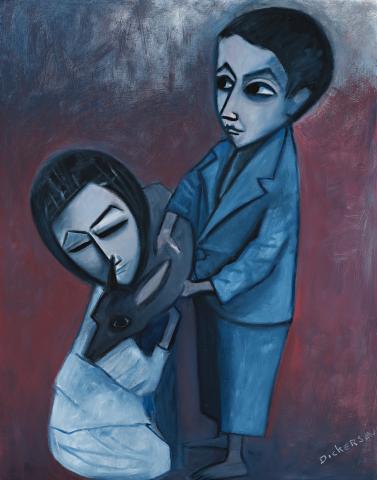TWO CHILDREN WITH A FAWN, 1971
ROBERT DICKERSON
oil on composition board
90.0 x 70.0 cm
signed lower right: DICKERSON
Roy and Nancy Melick, Sydney, acquired directly from the artist
Estate of Nancy Melick OAM, Sydney
Children with Fawn, 1954, oil on composition board, 122.0 x 91.0 cm, exhibited Fine Australian Paintings, Eva Breuer Art Dealer, Sydney, 1997, cat. 4 (illus.)
Two Children with a Fawn, 1971, contains many of the hallmarks of Robert Dickerson’s classic works. There is the motif of the embrace, the presence of children and the restricted palette that heavily utilises the dusky richness of blues and the strong, clear brushstrokes delineating the figures are painted with an assured confidence. The artist’s distinctive self-taught stylisation was resolved within his early works and was maintained throughout his career. His unwavering dedication to simplicity and directness of composition allowed space for painterly nuance and concentrated a palpable presence within his subjects. Robert Hughes wrote in succinct appreciation ‘the emotional power of some Dickersons – particularly those painted between 1954 and 1959 – is undeniable. Their laconic drawing controls the very dramatic situations they describe.’1
In the work on offer, the small well-groomed boy stands alert, protectively holding the fawn, with determination in his shadowed face as the other child crouches in an embrace of the interloping creature. This work relates closely to an earlier painting of the same subject, Children with Fawn, 1954, exhibited at the Rudy Komon Gallery in Sydney, which had been seen by Roy and Nancy Melick early in their ‘gallery going’ and was to them an enduring image. On a trip to Dickerson’s Indooroopilly studio in 1971, with colleague and collector, Keith Bruce, Roy sighted the re-visited painting of Two Children with a Fawn and purchased it on the spot.
There is often an undercurrent of getting by within the subjects of Dickerson’s paintings; here the little boy is barefoot, perhaps an autobiographical reference to Dickerson, whose 1994 biography includes a photograph of his own depression-era primary school class captioned ‘boys with shoes were placed in the front row.’2
Painting right up until his recent passing, Dickerson maintained his straightforward approach to his work, saying ‘I live in the world and need a reason to live. It’s no more complicated than that. I paint.’3 This matter-of-fact attitude spurred Dickerson on to become one of Australia’s most recognisable and revered modern artists. His iconic depictions of children within starkly rendered inner urban settings featured strongly within the artist’s retrospective exhibition held at Philip Bacon Galleries in 2014, including the work Boy Playing with Ball, 1965. The beginning of Dickerson’s long legacy can be seen from his involvement in the historically significant figurative exhibition ‘Antipodeans’ in August 1959, and in classic early works like Man sleeping on the steps,1952, acquired by the National Gallery of Victoria in 1954.
1. Hughes, R., The Art of Australia (rev. ed), Penguin Books, Melbourne, 1970, pp. 241–242
2. Dickerson, J., Against the Tide, Pandanus Press, Brisbane, 1994, p. 20
3. Bellamy, L., ‘Painting against the tide at 90’, The Sydney Morning Herald, 27 September 2014, p. 36
